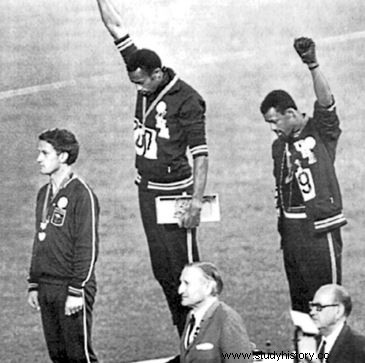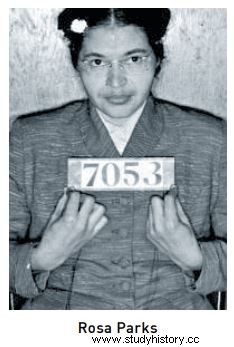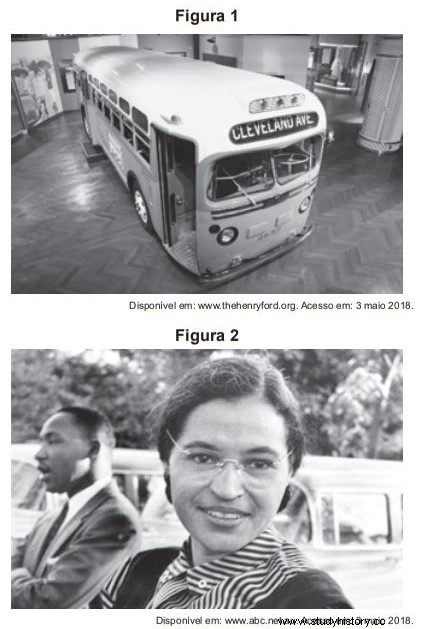Adapted from usafederalholidays.com. The establishment of national holidays is a political decision and is related to the historical and cultural particularities of societies. In the North American case, the non-adoption of Martin Luther King's Day in all states of the federation, since the creation of the holiday, is associated with the following aspect:
(A) partisan disputes
Question 03 - FATEC 2016 - Throughout history, the Olympic Games have served as a setting for various manifestations, individual or collective, of a political nature.

Question 06 - FAMERP 2019 - The statement that “the end of slavery in 1865 did not mean the end of racism or violence against blacks” can be exemplified

Question 08 - UERJ 2nd Qualifying Exam 2013 - The Story Bus
 |
| Rosa Parks. |
Murdered in 1968, Martin Luther King began his political activities in 1956, from the episode reported in the report. The main result of Martin Luther King's proposals for American society is directly related to:(A) unification of state laws (B) expansion of social equality (C) regulation of labor causes (D) universalization of civil rights Question 09 - Albert Einstein (Medicine) - 2018 - “With the resurgence of racial issues and violence against blacks by racist organizations such as the Klu Klux Klan, black leaders emerged who faced civil rights issues and reacted against police violence. [...] Martin Luther King and Malcolm X, among others, became that voice and, acting in different ways, were both revolutionary in their actions in favor of the cause of black people and civil rights in the USA. Only the bullets stopped them. (...)”https://anos60.wordpress.com/2008/02/04/direitos-civisnos-euablack-power/ Accessed:11/03/2017 Regarding the strategies used by these leaders, it is CORRECT to state that they were:a) analogous, due to the varied forms of struggle, ranging from the union between whites and blacks in street movements, to actions to convince groups of white congressmen, capable of defending the constitutional rights of blacks. b) complementary, insofar as Martin Luther King's actions sought to appease blacks after the confrontation in the street movements led by Malcolm X, and allowed for the necessary constitutional changes. c) divergent because, while Martin Luther King preached coexistence between whites and blacks and pacifism, based on Christian principles, Malcolm X incited the open struggle of blacks against whites, guided by a strong Muslim spirituality. d) convergent, since they were based on the principle of non-violence and only interfered in the progress of constitutional processes through the representation of black congressmen and, eventually, white democrat senators.
Question 10 - ENEM 2018 -

This bus is related to the act practiced, in 1955, by Rosa Parks, presented in a photograph alongside Martin Luther King. The vehicle achieved the status of a museum work for symbolizing the impact of the fear of the arms race. b) democratization of access to public schools. c) gender bias in public transport. d) deflagration of the movement for civil equality. e) outbreak of rebellion in youth behavior.
Question 11 - PUC-SP 2017 - “Poverty, discrimination, segregation, lynching and police violence — all of these characterized the life of black people in the United States in the 1950s. Building on the messages of freedom and prosperity in the official discourse and supported by their white allies, black people across the country, from both the formerly slave-holding states of the South and the North, built the most important movement in US history, the 'Civil Rights Movement'. By giving the word 'freedom' a new sense of equality and recognition of rights and opportunities, they managed to change racial, political and social relations in the United States, inspiring other Americans to fight for their rights.” Sean Purdy. “The other American dream”. In:História Viva, nº 54, April 2008.
Among the strands that made up the movement cited in the text, it is correct to mention
(A) the pacifist mobilization against the Vietnam War and Malcolm's struggle X for the conversion of blacks to Catholicism.
(B) Martin Luther King's principle of non-violent resistance and Malcolm X's proposal of direct self-defense action.
(C) the defense of full harmony between Black Panthers' whites and blacks and Martin Luther King's black evangelization project.
(D) the effort to provide assistance to communities that the Black Panthers oppressed and the Ku Klux Klan's rejection of segregationist policies.
/>INFORMATION 01 - D02 - B03 - C04 - C05 - A06 - C07 - C08 - D09 - C10 - D
11 - B
